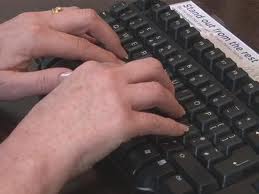
Flop that fiddle on your shoulder and put your fingers on the fingerboard. Ready to go, yes? Well, actually… no!
Right out of the cradle we’re pre-programmed to play the violin wrong. Our very first instinct actually works against us.
Hand a baby a rattle, and she grasps it. Hand a five year old a violin, and she does pretty much the same thing with her left (violin) hand. That grasping motion works great; it’s extremely powerful.
The only problem is that this type of power actually works against the violinist. What a violinist really needs is exactly the opposite thing, a delicate touch, freedom of movement and a high degree of finesse.
In the violin studio, even the teacher’s simple choice of a word can influence success or failure. I work hard to remove words such as “bow grip” from my vocabulary. Similarly we need to find the right word to describe how the violin hand approaches the instrument.

Touch Typing
I like the word “touch” as in touch typing. The touch typist on a modern keyboard uses a light, fast motion. His fingers are curved and his knuckles are high. Playing the violin well is amazingly much the same.
Playing the violin is much the same as typing an e-mail to a friend on your PCs keyboard.
The First Time Ever You Touch a Violin
Do this right the first time, and you’re off to a great start. Do it wrong, and you’ve got a bad habit. Minutes or seconds can establish the habit. It could take months to re-learn it the correct way.
Because a picture (or in this case a video) is worth one thousand words, I’m creating a video demonstration to help you get started. As always, this can work best under the supervision of a qualified teacher. So I’m not going to say “don’t try this at home” but then again, self-taught violinists are a rare breed indeed.
If you find any part of this unclear, please let me know. It’s my endeavor to make this the best it can be!
If you find this information helpful, please share or tweet this page or post, using the buttons below. Thanks!